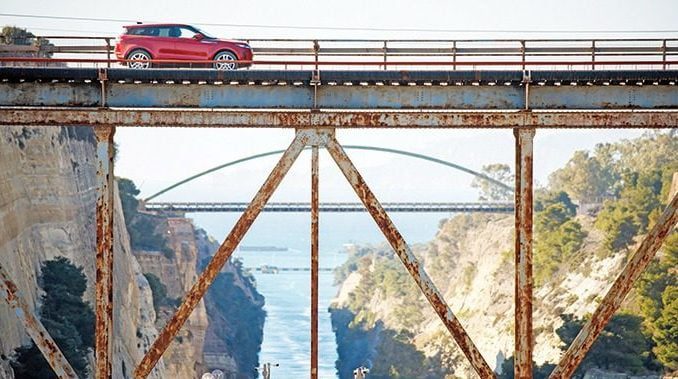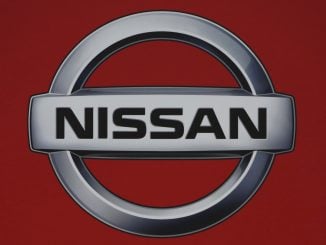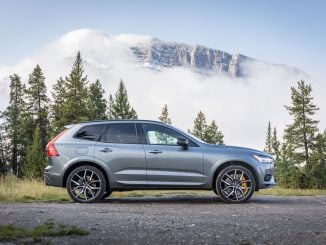
Car journalists spend a lot of time sitting around in hotel bars arguing with each other. After a long day of driving a fancy car around some exotic place like Tokyo or Fort Wayne, Indiana, jaded automotive writers will retire to the pub and proceed to drain the PR department’s expense account while debating an arcane piece of trivia like whether coupé should have an accent over the “e” or not.
And that’s how I found myself in a debate about whether the Range Rover Evoque reinvented the compact luxury SUV segment when it was first released back in 2011. I say: yes. Many of the cars in the red hot segment — Lexus NX, Jaguar F-Pace, Alfa Romeo Stelvio, Porsche Macan — didn’t even exist in 2011. In the end, it’s kind of irrelevant, but I like revolutionary cars which means I like the Evoque. And now there’s a brand new one.
Land Rover swears that every piece of the vehicle was reworked with the exception of the rear door hinges (which were perfect to begin with?). And yet, unless you really know your Evoques, one might be hard pressed to spot what’s new. Designwise, it’s all a little tighter. The Evoque’s trademark rising shoulderline and sloping roof is here, along with head and taillights adapted from its larger sibling, the gorgeous Range Rover Velar.
As to be expected from a Range Rover these days, the interior is luxurious and refined. Seats are comfortable, though given the size, rear-seat legroom and trunk space are tight. Don’t expect to throw two sets of golf clubs in the back, but a weekly grocery run should be alright.
The Evoque includes a pair of large touchscreens in the middle of the center column. One focuses on in-car entertainment and navigation, while the other swaps between climate control and adjustments for the various off-road modes (Sand, Grass-Gravel-Snow, Mud & Ruts) and more. There are a host of clever tricks for those venturing off the beaten path, including something Gradient Release Control that gently releases the brakes when driving down steep inclines to ensure that the vehicle doesn’t gain speed too quickly. The Evoque can also ford a rather ridiculous 23.6 inches of water, up from 19.7-inches in the prior version. Sure, you’ll never actually do that, but it’s nice to know that you could.
A ridiculously cool feature called “ClearSight Ground View” uses the Evoque’s forward- and side-facing cameras (plus some DVR-esque cleverness) to allow the driver to “look” underneath the car and navigate obstacles while watching exactly where the front wheels are on the large center screen. It’s a form of augmented reality that was developed in-house at Land Rover (and showed in concept form a few years ago as the “transparent bonnet”) and is something Evoque owners will enjoy showing off to the neighbors.
The bottom touch-screen in particular was a little difficult to use without taking your eyes off the road, but it was clearly designed for the driver to put everything in Auto — climate and off-road settings — and just leave it alone. The top screen, though gorgeous, uses a motorized tilt-function to rise out of the dash a bit. It’s cool, but seems a bit unnecessary. There’s also no good place to store your smartphone, which is unforgivable for a new car in 2019.
Other smart tech allows the Evoque to learn the driver’s habits — things like preferred temperature settings, favorite radio stations, and commonly dialed phone numbers depending on the time of day or day of the week.
Less immediately apparent, but more interesting in the long-run, is the 48-volt mild-hybrid powertrain. Going back decades, most vehicles use a 12-volt system to power the vehicle’s electronics. The Evoque has a 48-volt system that can harvest energy normally lost during deceleration and allows the engine to shut off earlier than most cars, improving fuel economy. Below 11 miles per hour, the engine will shut off when the driver applies the brakes, and stored battery power will be deployed during low-speed acceleration. In practice, this is all imperceptible, but should result in improved fuel economy, especially in stop-and-go city traffic.
Pricing starts in the mid-$40,000 range rising to the mid-$50’s on the higher trims. The British-built 2020 Range Rover Evoque is expected on North Carolina Land Rover dealer lots later this Spring.


